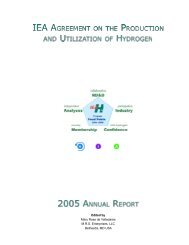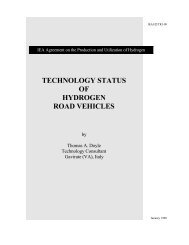Review of Small Stationary Reformers for Hydrogen Production
Review of Small Stationary Reformers for Hydrogen Production
Review of Small Stationary Reformers for Hydrogen Production
Create successful ePaper yourself
Turn your PDF publications into a flip-book with our unique Google optimized e-Paper software.
I. INTRODUCTION<br />
This report to the International Energy Agency (IEA) reviews technical options <strong>for</strong> small-scale<br />
production <strong>of</strong> hydrogen via re<strong>for</strong>ming <strong>of</strong> natural gas or liquid fuels. The focus is on small<br />
stationary systems that produce pure hydrogen at refueling stations <strong>for</strong> hydrogen-fueled<br />
vehicles. <strong>Small</strong> re<strong>for</strong>mer-based hydrogen production systems are commercially available from<br />
several vendors. In addition, a variety <strong>of</strong> small-scale re<strong>for</strong>mer technologies are currently being<br />
developed as components <strong>of</strong> fuel cell systems (<strong>for</strong> example, natural gas re<strong>for</strong>mers coupled to<br />
phosphoric acid or proton exchange membrane fuel cell (PAFC or PEMFC) cogeneration<br />
systems, and onboard fuel processors <strong>for</strong> methanol and gasoline fuel cell vehicles). Although<br />
fuel cell re<strong>for</strong>mers are typically designed to produce a “re<strong>for</strong>mate” gas containing 40%-70%<br />
hydrogen, rather than pure hydrogen, in many cases they could be readily adapted to pure<br />
hydrogen production with the addition <strong>of</strong> purification stages.<br />
As background, we first discuss hydrogen supply options <strong>for</strong> the transportation sector; both<br />
“centralized” (e.g. hydrogen production at a large central plant with distribution to refueling<br />
stations via truck or pipeline) and “distributed” (hydrogen production via small-scale re<strong>for</strong>ming or<br />
electrolysis at the refueling site). Several recent studies have suggested that distributed<br />
hydrogen production via small-scale re<strong>for</strong>ming at refueling stations could be an attractive near-<br />
to mid-term option <strong>for</strong> supplying hydrogen to vehicles, especially in regions with low natural gas<br />
prices.<br />
A variety <strong>of</strong> re<strong>for</strong>ming technologies that might be used in distributed hydrogen production at<br />
refueling stations are reviewed. These include steam methane re<strong>for</strong>ming (SMR), partial<br />
oxidation (POX), autothermal re<strong>for</strong>ming (ATR), methanol re<strong>for</strong>ming, ammonia cracking and<br />
catalytic cracking <strong>of</strong> methane. Novel re<strong>for</strong>mer technologies such as sorbent enhanced<br />
re<strong>for</strong>ming, ion transport membranes, and plasma re<strong>for</strong>mers are discussed. The per<strong>for</strong>mance<br />
characteristics, development status, economics and research issues are discussed <strong>for</strong> each<br />
hydrogen production technology.<br />
Current commercial projects to develop and commercialize small-scale re<strong>for</strong>mers are described.<br />
Finally, we suggest possibilities <strong>for</strong> future collaborative projects that might be undertaken by the<br />
IEA in this area.<br />
II. HYDROGEN SUPPLY OPTIONS FOR THE TRANSPORTATION SECTOR<br />
A. Motivation <strong>for</strong> <strong>Hydrogen</strong> as a Transportation Fuel: Environmental and Energy Supply<br />
Challenges Facing the Transportation Sector<br />
Globally, the number <strong>of</strong> vehicles, vehicle miles traveled and transportation energy demand are<br />
projected to grow rapidly in the next decades. Continued reliance on current fuels and vehicle<br />
technologies poses significant challenges with respect to air pollution, greenhouse gas<br />
emissions and energy supply security.<br />
� Combustion <strong>of</strong> fuels <strong>for</strong> transportation and heating contributes about two-thirds <strong>of</strong> all<br />
greenhouse gas emissions. Even with efficiency gains, it is likely that low- or zero-carbon<br />
fuels will be needed to meet future carbon emission reduction goals.<br />
� The transportation sector accounts <strong>for</strong> a large fraction <strong>of</strong> air pollutant emissions. Health and<br />
environmental effects <strong>of</strong> air pollutants (NOx, CO, VOCs, particulates) are leading to stricter<br />
tailpipe emissions regulations worldwide.<br />
3













